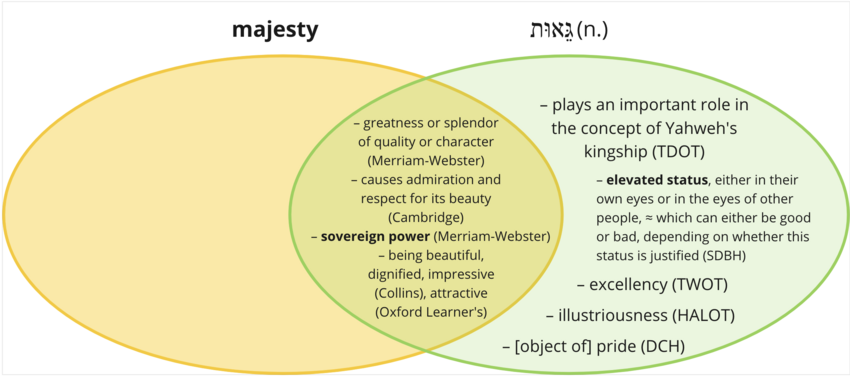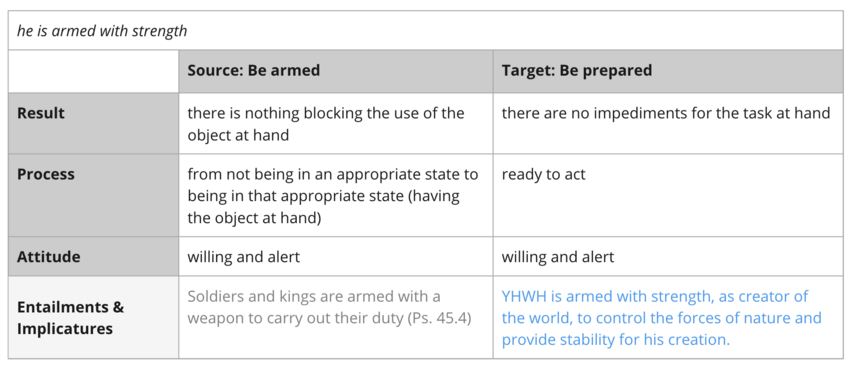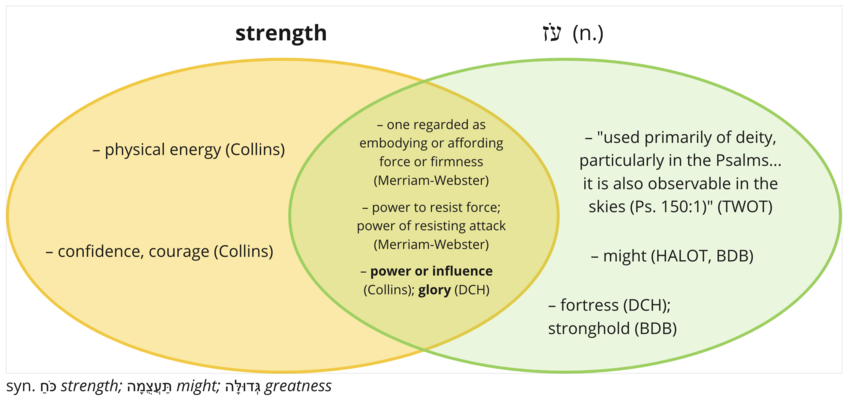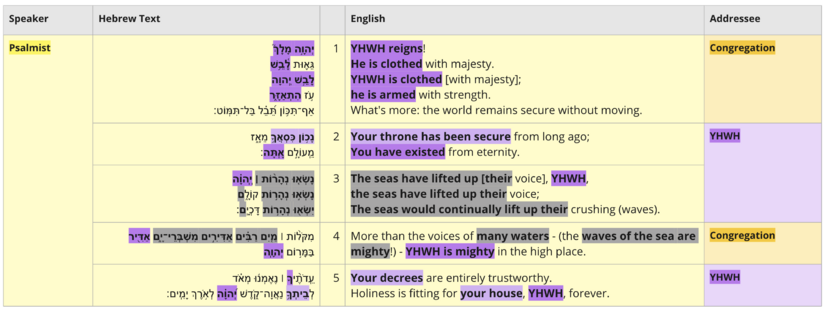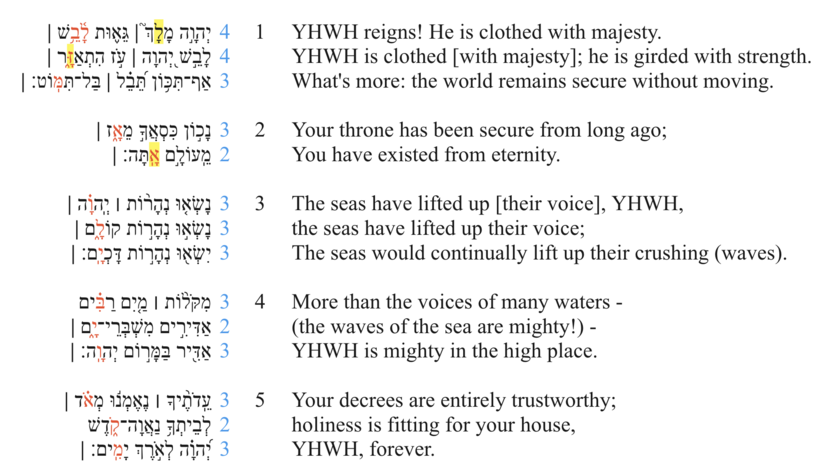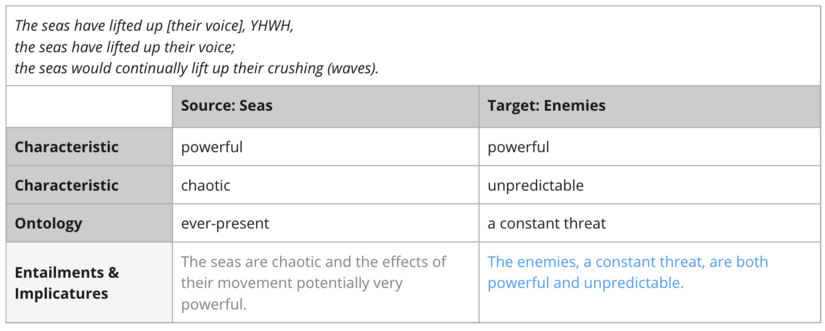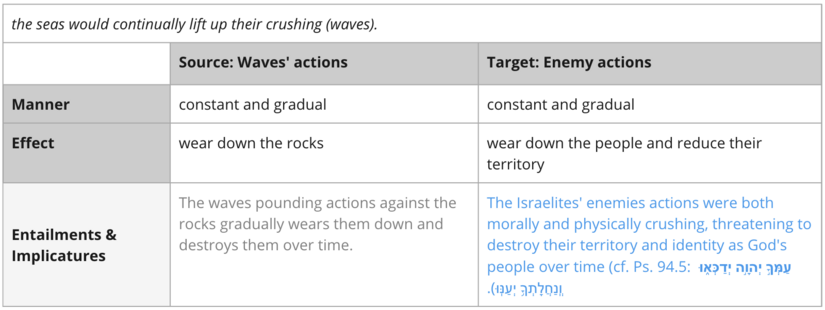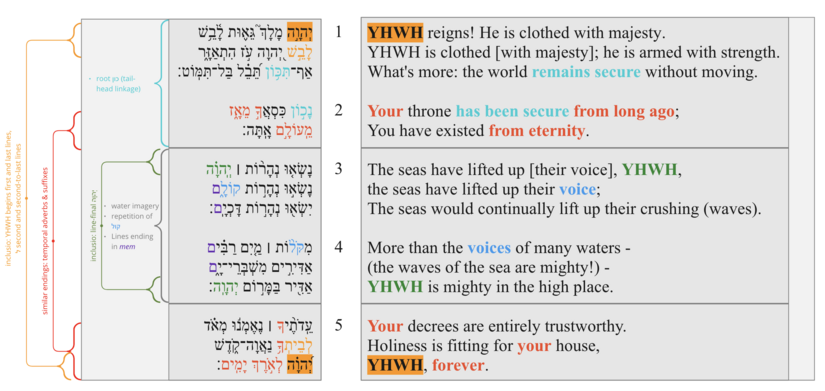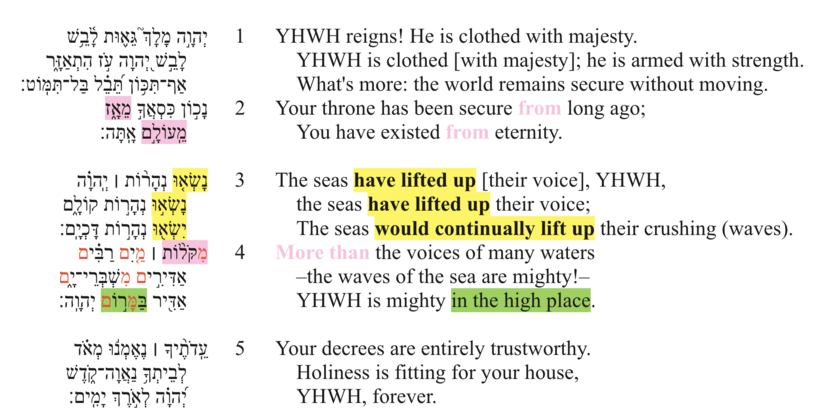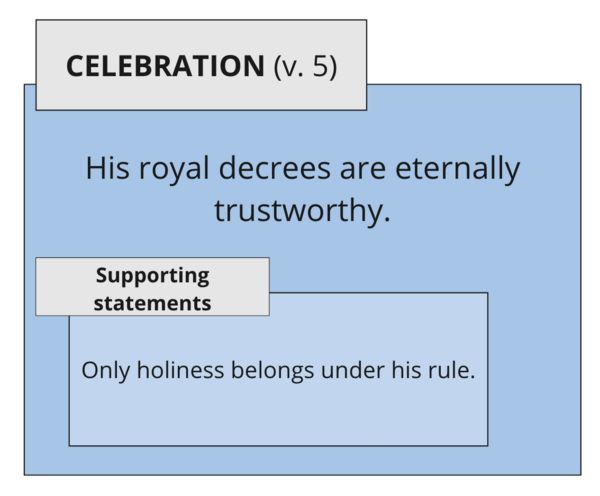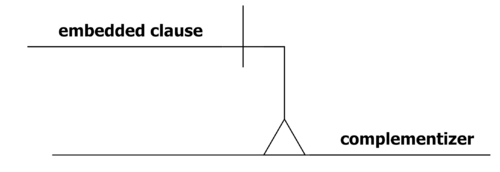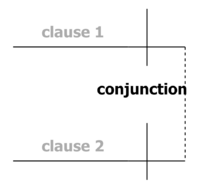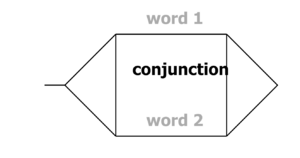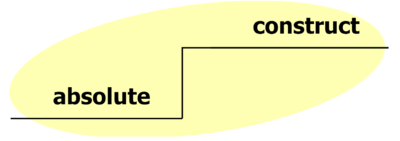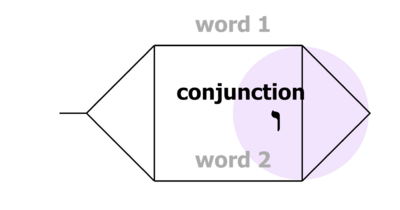Psalm 93 Verse by Verse
Verse-by-Verse Notes
Back to Psalm 93 overview page.
Welcome to the Verse-by-Verse Notes for Psalm 93!
The Verse-by-Verse Notes present scholarly, exegetical materials (from all layers of analysis) in a verse-by-verse format. They often present alternative interpretive options and justification for a preferred interpretation. The Verse-by-Verse Notes are aimed at consultant-level users.
The discussion of each verse of this psalm includes the following items.
- A link to the part of the overview video where the verse in question is discussed.
- The verse in Hebrew and English.[1]
- An expanded paraphrase of the verse.[2]
- A grammatical diagram of the verse, which includes glosses for each word and phrase.[3]
- A series of notes on the verse, which contain information pertaining to the interpretation of the psalm (e.g., meaning of words and phrases, poetic features, difficult grammatical constructions, etc.).
King forever (vv. 1-2)
v. 1
Watch the Overview video on v. 1.
| v. | Hebrew | Close-but-clear |
|---|---|---|
| 1a | יְהוָ֣ה מָלָךְ֮ גֵּא֪וּת לָ֫בֵ֥שׁ | YHWH reigns! He is clothed with majesty. |
| 1b | לָבֵ֣שׁ יְ֭הוָה עֹ֣ז הִתְאַזָּ֑ר | YHWH is clothed - he is armed with strength. |
| 1c | אַף־תִּכּ֥וֹן תֵּ֝בֵ֗ל בַּל־תִּמּֽוֹט׃ | What’s more: the world remains secure without moving. |
Expanded Paraphrase
YHWH reigns (forever, over the nations and over other gods) (- unlike Marduk or Baal)! He is clothed with majesty (as evident in his majestic acts). YHWH is clothed [with majesty]; he is armed with strength (to control the forces of nature and provide stability for his creation). What's more: the world remains secure without moving (ever since YHWH rebuked the waters and set their limits).
Grammatical Diagram
Notes
- While the discourse marker אַף indicates a macrosyntactic division before the final line of v. 1, the global speech act is unitary from vv. 1-4.
- Though lacking in the Masoretic text, the LXX of Psalm 93 begins with Regarding the day of the pre-Sabbath, when the earth had been settled. A laudation. Of an ode. Pertaining to David (NETS)[4] and the Qumran text 11Q5, "Hallelujah" (הללויה). According to the MT, however, the psalm begins with YHWH reigns, which is a key theme in this section of the Psalter's fourth book (see also Pss 96:10, 97:1 and 99:1). Strictly speaking, the verbal semantics could be understood as inchoative, YHWH has begun to reign or stative, YHWH reigns. In light of the content of v. 2, that both YHWH and his throne stretch back to eternity past, it is unlikely that מָלָךְ֮ here indicates the beginning of his reign.[5] Furthermore, the stative reading of YHWH currently reigning is preferred in the context of Ps. 93 because the majority of the verbs throughout the psalm are stative and all of them lack expected reference point movement (see the verbal semantics chart). As indicated in the diagram above, the complements of the stative verbs לבשׁ and התאזר, then, are considered nominal adverbs, i.e., clothes with majesty and armed with strength.[6]
- Concerning the term majesty, probably best understood to refer to an "elevated status" or "sovereign power", there is significant wordplay at work in the psalm (see the poetic feature Wordplay).[7]
- Furthermore, there is significant imagery at work in the mention of both clothed ("denoting an attribute properly belonging only to God"; Burton 2019: 298-299) and armed:
- Note that the hithpael stem of the verb אזר indicates that YHWH prepared himself (Tate 1990: 479),[8] that is, no one provided his strength for him, which speaks of the following:[9]
- The preferred reading of בַּל תִּמּוֹט is as a modifying subordinate clause, i.e. "circumstantial clause" (in the terminology of GKC §156g), "without shaking," though for the purpose of the diagram we have left the nature of this subordinate (manner) implicit.[10].
- The following alternative reads תֵּבֵל as the direct object, so the verb is read as 3ms (following LXX, Jerome, CEB, NRSVA, RVA [2015], DHH, CEI; cf. Baethgen 1904: 289) piel qatal from the root תכן (cf. HALOT). See also the unambiguous 1cs form in Ps. 75:4 (אָנֹכִ֨י תִכַּ֖נְתִּי עַמּוּדֶ֣יהָ). Nevertheless, the only Hebrew manuscript evidence which could fit this reading in Ps. 93:1 is 11Q5's תכן, which is compatible with the MT, but strangely defective (we would expect the full holem waw form for the תִּכּ֥וֹן, just as the MT). Besides the possibility of 11QPsª, there is no Hebrew manuscript evidence to support this emendation of the MT. Kennicott mentions a number of manuscripts (74, 76, 97, 117, 113, 235, 245) with the consonants תיכון (where the yod is plausibly a full reading of hireq), which are incompatible with the 3ms piel qatal from the root תכן. The continuity of the niphal כון in this verse as a tail-head linkage with the initial נָכ֣וֹן of v. 2 also favors the MT. Barthélemy (2005: 661) gives the MT a {B}.
v. 2
Watch the Overview video on v. 2.
| v. | Hebrew | Close-but-clear |
|---|---|---|
| 2a | נָכ֣וֹן כִּסְאֲךָ֣ מֵאָ֑ז | Your throne has been secure from long ago; |
| 2b | מֵֽעוֹלָ֣ם אָֽתָּה׃ | You have existed from eternity. |
Expanded Paraphrase
(Since the world's stability indicates the stability of YHWH's throne, therefore we can confidently proclaim:) Your throne has been secure from long ago; You have existed from eternity (and will reign forever).
Grammatical Diagram
Notes
- The addressee changes to YHWH in this verse (cf. also v. 5), as indicated by the second person forms, whereas vv. 1 and 4 refer to YHWH in the third person:[11]
- A mentioned in v. 1 above, the juxtaposition of the verb כון at the end of v. 1 and beginning of v. 2 is probably intentional: the world is stable because YHWH's throne is stable. Since YHWH's throne is stable and established on justice and righteousness, the earth can rejoice (Ps. 97:1-2; יְהוָ֣ה מָ֭לָךְ תָּגֵ֣ל הָאָ֑רֶץ יִ֝שְׂמְח֗וּ אִיִּ֥ים רַבִּֽים׃ עָנָ֣ן וַעֲרָפֶ֣ל סְבִיבָ֑יו צֶ֥דֶק וּ֝מִשְׁפָּ֗ט מְכ֣וֹן כִּסְאֽוֹ). Note that the stative participle and verbless clause have been rendered as perfect in the CBC due to the adverbials מֵאָז (from long ago) and מֵאוֹלָם (from eternity).
- This verse is the only verse of the psalm which contains two poetic lines:
- For the semantics of כִּסֵּא and the gloss throne, see the following Venn diagram:
Futile threats (vv. 3-4)
v. 3
Watch the Overview video on v. 3.
| v. | Hebrew | Close-but-clear |
|---|---|---|
| 3a | נָשְׂא֤וּ נְהָר֨וֹת ׀ יְֽהוָ֗ה | The seas have lifted up [their voice], YHWH, |
| 3b | נָשְׂא֣וּ נְהָר֣וֹת קוֹלָ֑ם | the seas have lifted up their voice; |
| 3c | יִשְׂא֖וּ נְהָר֣וֹת דָּכְיָֽם׃ | the seas would continually lift up their crushing (waves). |
Expanded Paraphrase
The seas (that is, raiding and exiling enemies, just as those cosmic threats of legend,) have lifted up [their voice], YHWH, the seas have lifted up their voice (in vain), (threatening to attack us and take us away); The seas would continually lift up their crushing (waves) (to crush us and take us into exile among the nations). (If they thought this would threaten YHWH's rule, it was all is in vain since YHWH's throne is stable!)
Grammatical Diagram
Notes
- The big question regarding this verse is the identity of the seas.[12] The chaotic nature of the seas has already been discussed in the exegesis of Psalms 24 and 29 (see the verse-by-verse notes there).
- What seems clear is that the lifting up their voice refers to verbal threats,[13] while lifting up their crushing (waves) may speak of threatening actions. For the attritional effects of the waves, which are constant and ultimately, over time, devastating, see the exegetical issue https://psalms.scriptura.world/w/The_Text_and_Meaning_of_Ps_93:3).[14]
- Note the alternation between the qatal and yiqtol verb forms (see Tatu 2006, 2008), resulting in the rendering would continually lift up for the latter.
- The Peshitta of the first and third verbs, however, are medio-passive ܐܬܬܪܝܡܘ (of the ethpeel verb stem; cf. BTX4ª's se elevan). This reading is made difficult with the object דָּכְיָֽם in the third clause, so the Syriac reads ܒܕܟܝܘܬܐ, "in purity."
- On this final word of the verse, see the full discussion in the exegetical issue https://psalms.scriptura.world/w/The_Text_and_Meaning_of_Ps_93:3).[15]
v. 4
Watch the Overview video on v. 4.
| v. | Hebrew | Close-but-clear |
|---|---|---|
| 4a | מִקֹּל֨וֹת ׀ מַ֤יִם רַבִּ֗ים | More than the sounds of many waters – |
| 4b | אַדִּירִ֣ים מִשְׁבְּרֵי־יָ֑ם | the waves of the sea are mighty! – |
| 4c | אַדִּ֖יר בַּמָּר֣וֹם יְהוָֽה׃ | YHWH is mighty in the high place. |
Expanded Paraphrase
More than the voices of many waters - the waves of the sea are mighty (; no one denies their power and persistence! Look what they did to the Egyptians!) - YHWH is mighty in the high place (, incomparable among the gods and majestic in holiness).
Grammatical Diagram
Notes
- This verse conclude the first global speech act (as noted in v. 1) and concludes the second section of the poetic structure (vv. 3-4). The enemies find their final mention in the present verse, while the addressee returns to the congregation, before one final section directed to YHWH in v. 5 (as noted in the Participant Analysis text table at v. 2).
- For syntax of verse, see the exegetical issue https://psalms.scriptura.org/w/The_Grammar_of_Ps._93:4, in which we prefer a parenthetical reading of the waves of the sea are majestic, in light of the grammatical difficulties otherwise.
- We understand the high place as "in heaven" (see the entries in BDB, DCH, HALOT; cf. also Pss 92:9; 102:20; 148:1 and, in the context of "many waters", Pss 18:17 and 144:7).[16] Nonetheless, it is selected intentionally and contributes to the poetic feature, Falling Short, as the final מ–initial constituent (see further discussion in the poetic feature).[17]
Trustworthy forever (v. 5)
v. 5
Watch the Overview video on v. 5.
| v. | Hebrew | Close-but-clear |
|---|---|---|
| 5a | עֵֽדֹתֶ֨יךָ ׀ נֶאֶמְנ֬וּ מְאֹ֗ד | Your decrees are entirely trustworthy. |
| 5b | לְבֵיתְךָ֥ נַאֲוָה־קֹ֑דֶשׁ | Holiness is fitting for your house, |
| 5c | יְ֝הוָ֗ה לְאֹ֣רֶךְ יָמִֽים׃ | YHWH, forever. |
Expanded Paraphrase
(Since he is holy, his throne is stable both when he acts in judgment and when we are at peace, so we can be confident that everything that comes from him is equally stable. Thus:) Your (royal) decrees are entirely trustworthy(, in no way threatened by judgment or exile, in the same way your reign is not threatened by the instability of the seas.). (You remain faithful to your covenant in both blessing and curse, since) Holiness is fitting for your house, YHWH, (in that you are dedicated to the holiness of your kingdom and we, as your people, are expected to pursue this same holiness in the land you have returned us to) forever (, as you have promised).
Grammatical Diagram
Notes
- The final verse represents the only development in the global speech act. Although it is another celebration, the differences in the details have been considered significant enough to warrant this division.
- While the connection between vv. 1-4 and v. 5 may not be immediately clear, it is crucial to bear in mind that YHWH established (יסד) his decrees (see, e.g., Ps 119:152) the same way he established (יסד) the world (see, e.g., Ps 24:1-2), as justification for our expanded paraphrase.
- The final line of the third section of the poetic structure contains a line-initial YHWH, just as in the first line of the psalm, and concludes by picking up the temporal adverbs dominant in v. 2. Whereas previously they stretched into eternity past, the psalm ends on a note of assurance forever.
- The second clause, however, (holiness is fitting for your house, YHWH, forever) offers a final assertion within a passage of praise in the psalm's celebration. [18]
- For discussion of the word נַאֲוָה, translated appropriate, see the exegetical issue https://psalms.scriptura.org/w/The_Meaning_of_Ps_93:5b.[19] See, also, v. 1 above for discussion of the poetic feature, Wordplay, of which נַאֲוָה is the third and final lexeme discussed.
- The final line may alternatively be read "The Lord is forever".[20] Such a reading is not followed by any translation, however, ancient or modern.
=Legends=
'''Grammatical diagram'''
{{Grammatical Legend/Button}}
'''Shapes and colours on grammatical diagram'''
{{Phrasal Legend}}
'''Expanded paraphrase'''
{{Story Behind}}
=Bibliography=
=Footnotes=
[[Category:Verse-by-Verse Notes]]
[[Chapter::#]]
Legends
Grammatical diagram
| Visualization | Description |
|---|---|
| The clause is represented by a horizontal line with a vertical line crossing through it, separating the subject and the verb. | |
| The object is indicated by a vertical line that does not cross the horizontal line of the clause. Infinitives and participles may also have objects. If the direct object marker (d.o.m.) is present in the text, it appears in the diagram immediately before the object. If the grammar includes a secondary object, the secondary object will appear after the object, separated by another vertical line that does not cross the horizontal line of the clause. | |
| The subject complement follows the verb (often omitted in Hebrew) separated with a line leaning toward the right. It can be a noun, a whole prepositional phrase or an adjective. The later two appear modifying the complement slot. | |
| When a noun further describes or renames the object, it is an object complement. The object complement follows the object separated by a line leaning toward the right. | |
| In a construct chain, the noun in the absolute form modifies the noun in the construct form. | |
| Participles are indicated in whatever position in the clause they are in with a curved line before the participle. Participles can occur as nominal, where they take the place of a noun, predicate, where they take the place of a verb, or attributive, where they modify a noun or a verb similar to adjectives or adverbs. | |
| Infinitives are indicated by two parallel lines before the infinitive that cross the horizontal line. Infinitive constructs can appear as the verb in an embedded clause. Infinitive absolutes typically appear as an adverbial. | |
| The subject of the infinitive often appears in construct to it. In this situation, the infinitive and subject are diagrammed as a construct chain. | |
| The object of the infinitive is indicated by a vertical line that does not cross the horizontal line of the infinitival clause. | |
| Modifiers are represented by a solid diagonal line from the word they modify. They can attach to verbs, adjectives, or nouns. If modifying a verb or adjective, it is an adverb, but if modifying a noun, it is an adjective, a quantifier, or a definite article. If an adverb is modifying a modifier, it is connected to the modifier by a small dashed horizontal line. | |
| Adverbials are indicated by a dashed diagonal line extending to a horizontal line. These are nouns or infinitives that function adverbially (modifying either a verb or a participle), but are not connected by a preposition. | |
| Prepositional phrases are indicated by a solid diagonal line extending to a horizontal line. The preposition is to the left of the diagonal line and the dependent of the preposition is on the horizontal line. They can modify verbs (adverbial) or nouns (adjectival). | |
| Embedded clauses are indicated by a "stand" that looks like an upside-down Y. The stand rests in the grammatical position that the clause fulfills. Extending from the top of the stand is a horizontal line for the clause. If introduced by a complementizer, for example כִּי, the complementizer appears before the stand. Embedded clauses can stand in the place of any noun. | |
| When clauses are joined by a conjunction, they are compound clauses. These clauses are connected by a vertical dotted line. The conjunction is placed next to the dotted line. | |
| Within a clause, if two or more parts of speech are compound, these are represented by angled lines reaching to the two compound elements connected by a solid vertical line. If a conjunction is used, the conjunction appears to the left of the vertical line. Almost all parts of speech can be compound. | |
| Subordinate clauses are indicated by a dashed line coming from the line dividing the subject from the predicate in the independent clause and leading to the horizontal line of the subordinate clause. The subordinating conjunction appears next to the dashed line. | |
| Relative clauses also have a dashed line, but the line connects the antecedent to the horizontal line of the relative clause. The relative particle appears next to the dashed line. | |
| Sentence fragments are represented by a horizontal line with no vertical lines. They are most frequently used in superscriptions to psalms. They are visually similar to discourse particles and vocatives, but most often consist of a noun phrase (that does not refer to a person or people group) or a prepositional phrase. | |
| In the body of the psalm, a horizontal line by itself (with no modifiers or vertical lines) can indicate either a discourse particle or a vocative (if the word is a noun referring to a person or people group). A discourse particle is a conjunction or particle that functions at the discourse level, not at the grammatical level. Vocatives can appear either before or after the clause addressed to them, depending on the word order of the Hebrew. | |
| Apposition is indicated by an equal sign equating the two noun phrases. This can occur with a noun in any function in a sentence. |
| Hebrew text colors | |
|---|---|
| Default preferred text | The default preferred reading is represented by a black line. The text of the MT is represented in bold black text. |
| Dispreferred reading | The dispreferred reading is an alternative interpretation of the grammar, represented by a pink line. The text of the MT is represented in bold pink text, while emendations and revocalizations retain their corresponding colors (see below). |
| Emended text | Emended text, text in which the consonants differ from the consonants of the Masoretic text, is represented by bold blue text, whether that reading is preferred or dispreferred. |
| Revocalized text | Revocalized text, text in which only the vowels differ from the vowels of the Masoretic text, is represented by bold purple text, whether that reading is preferred or dispreferred. |
| (Supplied elided element) | Any element that is elided in the Hebrew text is represented by bold gray text in parentheses. |
| ( ) | The position of a non-supplied elided element is represented by empty black parentheses. For example, this would be used in the place of the noun when an adjective functions substantivally or in the place of the antecedent when a relative clause has an implied antecedent. |
| Gloss text colors | |
|---|---|
| Gloss used in the CBC | The gloss used in the Close-but-Clear translation is represented by bold blue text. |
| Literal gloss >> derived meaning | A gloss that shows the more literal meaning as well as the derived figurative meaning is represented in blue text with arrows pointing towards the more figurative meaning. The gloss used in the CBC will be bolded. |
| Supplied elided element | The gloss for a supplied elided element is represented in bold gray text. |
Shapes and colours on grammatical diagram
| Visualization | Description |
|---|---|
| The prepositional phrase is indicated by a solid green oval. | |
| The construct chain is indicated by a solid yellow oval. | |
| When the conjunction ו appears at the phrase-level (not clause-level), it is indicated by a solid light purple oval. | |
| The article is indicated by a solid blue oval. |
Expanded paraphrase
| Expanded paraphrase legend | |
|---|---|
| Close but Clear (CBC) translation | The CBC, our close but clear translation of the Hebrew, is represented in bold text. |
| Assumptions | Assumptions which provide background information, presuppositions, entailments, and inferences are represented in italics. |
Bibliography
Footnotes
93
- ↑ The Hebrew text comes from Open Scriptures Hebrew Bible, which presents the text of the Leningrad Codex (the Masoretic text). The English text is our own "Close-but-clear" translation (CBC). The CBC is a “wooden” translation that exists to provide a window into the Hebrew text. It is essentially an interlinear that has been put into English word-order. It is also similar to a “back-translation” (of the Hebrew) often used in Bible translation checking. It is important to remember that the CBC is not intended to be a stand-alone translation, but is rather a tool for using the Layer by Layer materials. The CBC is used as the primary display text (along with the Hebrew) for most analytical visualisations. It is also used as the display text for most videos.
- ↑ A legend for the expanded paraphrase is available near the bottom of this page, in the section titled "Legends."
- ↑ Legends for both the grammatical diagram and the shapes and colours on the grammatical diagram are available near the bottom of this page, in the section titled "Legends."
- ↑ Εἰς τὴν ἡμέραν τοῦ προσαββάτου, ὅτε κατῴκισται ἡ γῆ· αἶνος ᾠδῆς τῷ Δαυιδ.
- ↑ Indeed, just a few psalms previously, we read Before the mountains were birthed and you brought forth the earth and the world, from forever and until forever you are God (Ps. 90:2; בְּטֶ֤רֶם׀ הָ֘רִ֤ים יֻלָּ֗דוּ וַתְּח֣וֹלֵֽל אֶ֣רֶץ וְתֵבֵ֑ל וּֽמֵעוֹלָ֥ם עַד־ע֝וֹלָ֗ם אַתָּ֥ה אֵֽל). Since the motivation for the translation YHWH has begun to reign stems from a hypothesised enthronement festival which celebrates YHWH finished work of creation, it is clear that YHWH was God even before this, so need not be newly enthroned. See Tate 1990: 472 for discussion and a defence of YHWH reigns.
- ↑ An alternative reading involves גֵּאוּת as the direct object rather than adverbial. The question is whether qatel לב׳׳ש is considered a transitive verb in BH, not whether we need to gloss with an adverbial. It is probably significant that it is pointed as stative, whereas qatal is a possible alternative (cf. Lev. 16.23), so the adverbial reading is preferred (see BHRG p. 76). "The verb לָבַשׁ/לָבֵשׁ can have either a stative or an active sense (i.e.,“be clothed” or “put on”), as indicated by its qātal/qātēl alternation. In Ps. 93:1 the stative is clearly present, and the same is likely true in Ps. 104:1, though the 2ms form does not allow the distinction to be observed" (Burton 2019: 299 n46). Blau (2010: 220) tries to argue that the qatel form is only present here as it is in pause (contra Revell) but, even if true, this doesn't account for the second form (cf. Fassberg 2019 §235). "From a synchronic perspective there is a clear semantic relation between the two senses: dynamic = entering into the state of being dressed, stative = being in a state of being dressed. Or, perhaps more simply and to include the typical Obj [Dress], dynamic = Subj puts on clothing, and stative = Subj is dressed in clothing" (Coleman 2018: 90). Indeed, commenting on Haggai 1:6, Coleman states, "From a discourse prominence perspective, it is the affectedness of the agent that is in view" (2018: 87). Applied to Ps 93:1, we may slightly adapt this take and understand the identity of the agent in the second case (1c) and therefore most likely adverbial in the first (1b).
- ↑ Each of the three strophes of Ps 93 contains either a hapax legomenon (דָּכְיָם and נַאֲוָה) or a relatively rare word (גֵּאוּת). (For the unique nature of נַאֲוָה as a palel verb stem from the root נאה see the exegetical issue, https://psalms.scriptura.world/w/The_Meaning_of_Ps_93:5b.) These (or similar sounding) words are found in related texts. The word גֵּאוּת appears in Ps 89:10; the root דכא/ה appears in Pss 89:11; 90:3; 94:5; and the phrase נְוֵ֥ה קָדְשֶֽׁךָ (which sounds similar to נַאֲוָה־קֹ֑דֶשׁ) appears in Ex 15:13. These three rare or unique words have been intentionally selected and placed throughout the psalm. The message of the psalm concerns the superiority of the majesty of YHWH over the majesty of the waves (v. 4), which are rising up (v. 3). Thus it is fitting that the second clause of the entire psalm describes YHWH as clothed with גֵּאוּת, the same word used (only once in the Hebrew Bible) to refer to the rising up of the waves, which God is said to rule over in Ps. 89:10 (אַתָּ֣ה מ֭וֹשֵׁל בְּגֵא֣וּת הַיָּ֑ם בְּשׂ֥וֹא גַ֝לָּ֗יו אַתָּ֥ה תְשַׁבְּחֵֽם׃). These may be 'majestic' in a sense (cf. Ps 93:4b), but are no comparison to the majesty with which YHWH is clothed.
- ↑ The fact that the Ancient Versions take עֹז as an argument in the previous לב׳׳שׁ VP, would indicate that, like Isa. 8.6, the intransitive use of the hithpael is in view here also. Furthermore, since Niphal was also a possibility (65.7: מֵכִ֣ין הָרִ֣ים בְּכֹח֑וֹ נֶ֝אְזָ֗ר בִּגְבוּרָֽה) the reflexive nature of the action seems to be profiled here (Coleman 2018: 104-106).
- ↑ Burton comments, "עֹז is the means by which God controls the forces of nature... and sustains people..., Thus, God is clothed in power by which he directs all things" (2019: 299) .
- ↑ It may be best understood an asyndetic relative clause (as the Ancient Versions), though a purpose clause is also a possible reading of the דלא/ܕܠܐ in Targum Psalms and the Peshitta
- ↑ Indeed, v. 2b is the only place in the psalm where the clausal subject is not in the third person.
- ↑ "El Sal 93 no lo dice, pero tampoco se resiste a ser leído en esa clave simbólica. Concretamente, leído en el contexto del destierro, podía el salmo desplegar una gran fuerza polémica contra los dioses y el poder político de Babilonia, como leemos en varias páginas del profeta del destierro" (Alonso-Schökel 1993); "Some commentators take these to be symbolic references to the nations which were Israel’s enemies, such as Egypt and Assyria (see Kirkpatrick); but it is more likely that the reference is to the powers defeated at creation." (Bratcher & Reyburn 1991: 815); "Das Toben der wild einherstürmenden Wogen ist ein Bild für das Toben feindlicher Menschenmächte" (Baethgen 1904: 290).
- ↑ Possibly the "roaring of the hostile nations against Yahweh and Israel" (à la Ps 2; Tate 1990: 479); "The “sea” or “river” is also a metaphor of the nations (cf. Ps 89:9-10; Isa 8:7-8; Jer 46:7-8)" (VanGemeren 2008).
- ↑ A less likely, but alternative reading, is the interpretation of the noise the seas produce as praise, as Targum Psalms understands the present verse (). We may also find support for such a reading in Ps 96:10-11 and the context of Revelation 19:6, which speaks of hearing something like the voice of a great crowd and the sound of many waters (ὡς φωνὴν ὑδάτων πολλῶν), which is almost identical to the LXX of v. 4 (ἀπὸ φωνῶν ὑδάτων πολλῶν). Revelation 19:6 is also the only place in the New Testament where we find the phrase "The Lord reigns" (ἐβασίλευσεν κύριος), just as we have here in v. 1 (Ὁ κύριος ἐβασίλευσεν).
- ↑ See similar uses of the same root דכא/ה in Pss 89:11; 90:3; and 94:5. Targum Psalms of our current verse reads completely differently, with בשירתא יקבלון נהרוותא אגר שבחיהון (the rivers will receive a reward for their praise (Stec 2004, 177). The clause is absent in LXX, but the Gallican Psalter adds elevabunt flumina fluctus suos, apparently following Theodotion. Origen reads ἀροῦσιν οἱ ποταμοὶ ἐπιτρίψεις αὐτῶν (ἐπίτριψις as wearing away [of the waves] LSJ; the nominal from the verbal form ἐπιτρίβω, grind down, crush, pound; CGL 2021: 582); and Aquila, ἐπήρθη ποταμῶν βάθη αὐτῶν). See also the LXX of בָּ֥אתִי בְמַעֲמַקֵּי־מַ֝֗יִם in Ps. 69.3: ἦλθον εἰς τὰ βάθη τῆς θαλάσσης; Luke 5.4: Ἐπανάγαγε εἰς τὸ βάθος καὶ χαλάσατε τὰ δίκτυα ὑμῶν εἰς ἄγραν). Jerome's Iuxta Hebreaos contains gurgites from gurges, "floods." Kennicott mss 97 and 133 read דוכיים, mss 38, 131 and 142 reads דוכים, and mss 37, 73, 74, 93, 220, 680 and 681 read דכיים. We have Ugaritic cognates d-k-k, attested in the passive be pounded, ground; Akkadian dakāka: zermalmen (crush, grind, pound), zerkleinern (shred); and Arabic dakka, dāka: break, crush, bruise, pound (Del Olmo & Sanmartín 2015: 267). TDOT further notes that it corresponds to Old South Arabian dkw, and perhaps to Phoen. dky (1978, 197 n. 13) and its Ugaritic use is as "a divine epithet... a noun form of the verb dk, to compound" (ibid. 198; cf. CTA 6 [I AB] V. 1-3).
- ↑ In Exodus 15:10, the waters are likewise described as majestic (נָשַׁ֥פְתָּ בְרוּחֲךָ֖ כִּסָּ֣מוֹ יָ֑ם צָֽלֲלוּ֙ כַּֽעוֹפֶ֔רֶת בְּמַ֖יִם אַדִּירִֽים׃), while in the next verse we are reminded that there is no one like YHWH, who is majestic in holiness (מִֽי־כָמֹ֤כָה בָּֽאֵלִם֙ יְהוָ֔ה מִ֥י כָּמֹ֖כָה נֶאְדָּ֣ר בַּקֹּ֑דֶשׁ נוֹרָ֥א תְהִלֹּ֖ת עֹ֥שֵׂה פֶֽלֶא׃).
- ↑ In short, YHWH's reign and majesty are superior to the mighty waters because he, being eternal and reigning eternally, created them. The dominance of the consonant mem throughout v. 4 perhaps iconically represents the waters (מַיִם), with the result that the comparison is hinted at even in the word high place (מָרוֹם), containing the final two instances of mem in the verse.
- ↑ Thus, there may be a perlocutionary effect produced by the psalmist's zeal that the congregation live in holiness in order to dwell forever in YHWH's house and overcome enemy threats, despite YHWH being the addressee in this verse.
- ↑ Note that though 4QPs-b reads only נוה for נַאֲוָה, the dropping of radical aleph in word-medial position is very common in Qumran manuscripts (see Qimron 2018: 81).
- ↑ See Bratcher & Reburn 1991:817 and Alter 2019:224).




